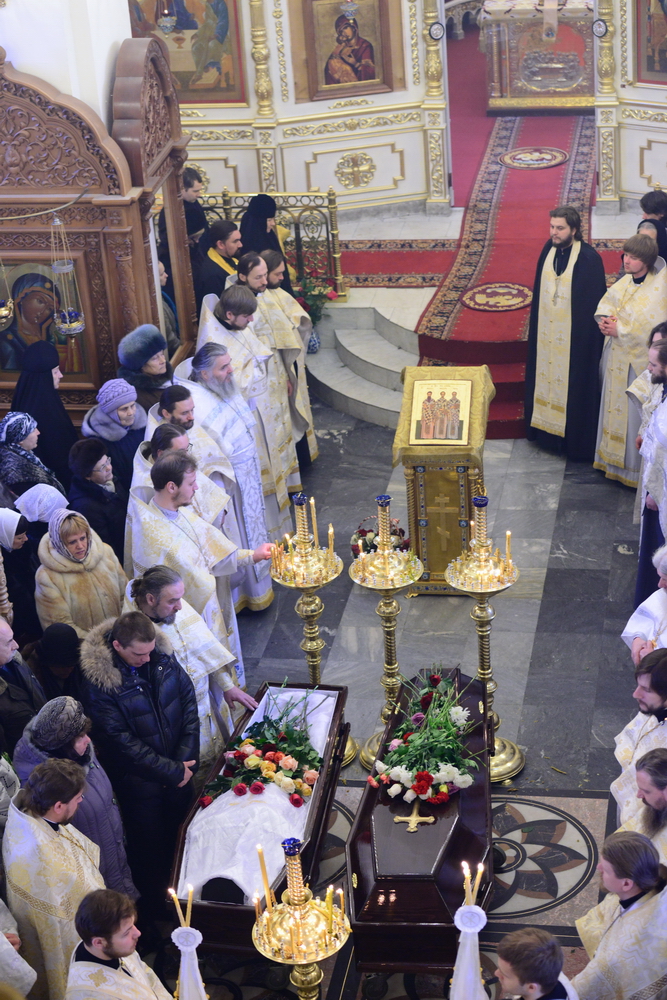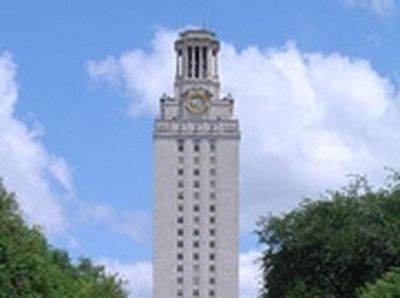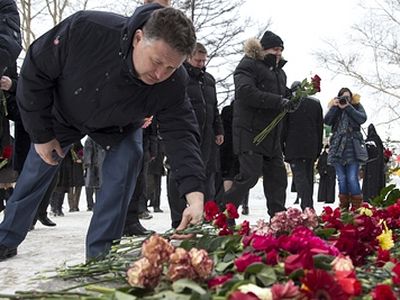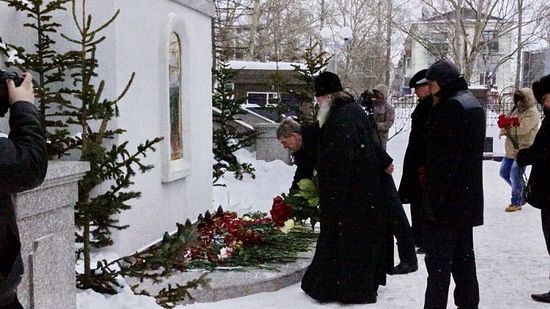 The walls of the cathedral. February 9, 2014
The walls of the cathedral. February 9, 2014
On Sunday, February 9, the Russian Orthodox Church celebrated the memory of the Holy New Martyrs and Confessors of Russia—those who met their death during the Soviet period at the hands of atheists, or more exactly anti-theists—people who “war against God”. As Orthodox Christians not only in Russia but around the globe attended services and sang the praises of these righteous ones of the comparatively recent past, little did they suspect that two more Russians Orthodox Christians in the Russian far east would die that day, in a way that can only be called martyric. Who were these two martyrs, and what motivated the young man whom everyone described as an ordinary Russian guy, indistinguishable from anyone else in the church until he opened fire on the worshippers assembled there?
Yuzhno-Sakhalinsk
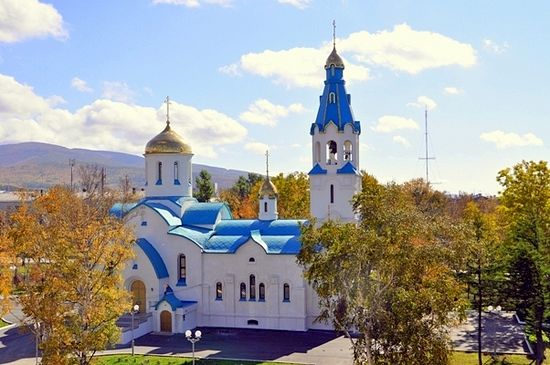
Yuzhno-Sakhalinsk, or South Sakhalinsk, is the largest city on Sakhalin Island in the Russian Far East. The climate is very cold in the winter, with moderate, foggy summers. Originally settled by Russian prisoners during Tsarist times, it was lost to Japan after the Russo-Japanese War in 1905, along with the southern part of the island. Japan’s defeat in the Second World War forced it to cede the territory back to the Soviet Union, and although the issue of ownership has arisen again since the USSR’s collapse, the territory remains part of the Russian Federation. It is rich in natural resources, namely oil and gas, but although this has brought economic growth, the majority of the population is poor, and the region around the city has the highest juvenile crime rate in all of Russia.
The Russian Orthodox Church has been in this region, originally inhabited by indigenous far eastern peoples, since the late 19th century, when the Russian empire began sending missionaries there. Sakhalin was where prisoners were sent, and churches were built in the resulting towns and villages. Yuzhno-Sakhalinsk also began its existence as a prisoners’ settlement in 1882, called Vladimirovka at the time. The Soviet period saw all the churches in Sakhalin destroyed or used for other, profane purposes. With the fall of the soviet regime, the Russian Orthodox Church once again began its missionary work on the island—both to the indigenous peoples and to the Russian population. The first church built there during this period was dedicated to St. Xenia of Petersburg in 1989, and in 1990, Metropolitan Pitirim of Volokolamsk consecrated the foundation of the Cathedral of the Resurrection of Christ in Yuzhno-Sakhalinsk. Construction was completed and the cathedral was opened in 1995. Since then, around ten churches have been built on the island, along with Sunday Schools and centers for religious education.
Because the Russian population in Sakhalinsk is largely transitory, it was not easy to revive Orthodox life there. Bishop Daniel (Dorokhov), now Metropolitan of Archangelsk, was sent to Sakhalin from the Holy Trinity-St. Sergius Lavra when the new Sakhalin and Kuril Islands diocese was formed, and most of the work took place during his time as ruling bishop there in that diocese. In a relatively short time, however, much has been done to establish church life in Sakhalin.
Although the people of Sakhalin are mostly well disposed to the Orthodox Church, and its programs on the island have only brought good, there are some who do not like the fact that people are turning to God. The envier of mankind is especially displeased with the building of churches and religious education of these nearly forgotten people. This was expressed even before the attack on February 9. In August, 2012, for example, satanists vandalized the cathedral and church dedicated to St. Innocent of Moscow, the enlightener of Alaska and Kamchatka. During the night, they defaced the churches with satanic phrases and symbols.
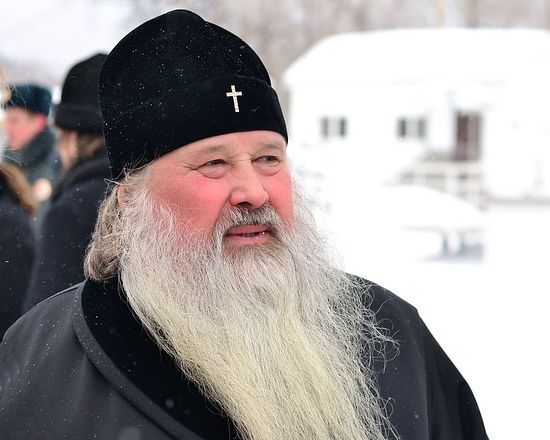 Bishop Tikhon of Yuzhno-Sakhalinsk and Kuril
Bishop Tikhon of Yuzhno-Sakhalinsk and Kuril
Bishop Tikhon of Yuzhno-Sakhalinsk and Kuril commented on this incident, which shook the island then.
I received the news about this vandalism with sorrow—sorrow over the spiritual and moral sickness present in our society. These blasphemous acts speak, unfortunately, about the fact that attacks are being made on our fundamental values, spiritual and moral; an attack on everything that uphold us. Of course, I feel sorry for these people, and sorrow over what they are doing. I am convinced that they know not what they do. May God grant that they would come to reason and understand that they cannot rock the boat in which all the people of the world are sitting.
The rector of the church, Archpriest Victor Gorbach, commented:
We have already lived through a war against churches. At the beginning of the twentieth century, our people destroyed themselves with just such slogans as these. I am sad for these people. After all, God will not be mocked, and they are destroying themselves. In Holy Scripture are these words: If in sinning a man sins against a man, and they shall pray for him to the Lord, and if he sins against the Lord, who shall pray for him? (1 Kings 2:25)…
If people can make sense of this and make a correct assessment of what has happened, then our society has a future.
There have been other vandalism attacks by satanists against churches on Sakhalin since then, but this satanic hatred of the Orthodox Church became especially obvious on the Sunday of Holy New Martyrs and Confessors of Russia, February 9, 2014, when a young man named Stepan Komarov, a neo-pagan, came into the Cathedral of the Resurrection of Christ in Yuzhno-Sakhalinsk and began firing at the people there.
It had been a grace-filled day—many people had attended the Liturgy that morning to receive Communion and congratulate Bishop Tikhon with his elevation to the episcopal rank. They had served a Pannikhida for those killed during the years of persecution against the Church by the Communists. Fortunately most of the people had already left the church when Komarov came in. “It was just like the revolutionary years, when people burst into churches with rifles. Icons were shot at, and a bullet even hit the High Place in the altar,” Nun Hilariona, who also serves in the Cathedral, described the scene.
Six people were seriously wounded, and a number of others received minor injuries. However, all of those hospitalized have since been released. It seems that the full extent of the blow was taken by two people: Nun Liudmila (Pryashnikova), and a man named Vladimir Zaporozhets.
Nun Hilariona, who knew Mother Liudmila well, described the event:1
“Matuskha was standing behind the candle-selling stand, and that is where she fell. I don’t know if she had an opportunity to flee when the shooting began. The only thing I can say is that she was one of the first to receive a blow: the candle stand is located to the right, just as you walk into the cathedral.
“I don’t know if she had the opportunity to escape her fate. But even if there was—when a man bursts into the church with a rifle, what is the first thought a nun has? To save the people.
“On the territory of our cathedral is a spiritual-educational center. There is an entryway there, and the ecclesiarch of our cathedral and his assistant just happened to be there at the time. As soon as they heard the shots, they ran straight to the cathedral. One of the novices, Alexei, began pulling out the wounded—there were many. Those who were only slightly wounded were taken in buses to the trauma center, but those who could not walk by themselves (they were mostly injured in the legs) were taken quickly to the lower church. This man carried many people out under threat of his own death. He did very much.
“I arrived when the gunman was already arrested. Vladyka was in the diocesan administration building located some distance from the cathedral, and therefore did not hear the shots…”
Nun Liudmila
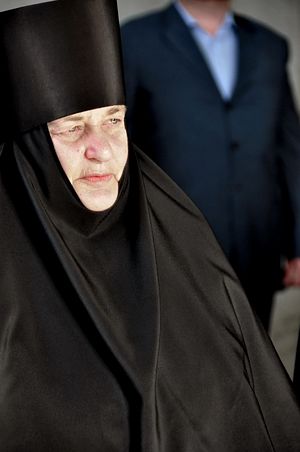 Nun Liudmila (Pryashnikova)
Nun Liudmila (Pryashnikova)
“Matushka was an example to all. You’ll rarely meet such a magnanimous, warm, and loving person as her. She showed her Christianity by her very way of life.
“We do not have many nuns here, but Matushka was one of the best. The light of Christ that she bore within herself cannot be described in words…”
“I have probably never met such a kind and amiable person in my life. She was unique. The most amazing thing to me is the parallel—that as a nun, she departed this world on the day of the New Martyrs and Confessors of the Russian Church, and she herself was tonsured into the mantia in honor of New Martyr Liudmila Petrova.2 This is a very important fact. I believe that she is in paradise—the martyric scene and her way of life leave no doubt of this…
“The Lord probably chose the best—at least of the nuns. This is my subjective opinion.
“She had the rare quality of never entering into conflict with anyone. I do not remember a single instance of her arguing with anyone, trying to get the upper hand, or trying to make a place for herself under the sun… There was never anything like that.
“She bore her obedience peacefully, with humility and love, and with such dignity that she was an example to all. She was a true Christian.”
Vladimir Zaporozhets
The other person killed on that day was Vladimir Zaporozhets. Little is known about the life of this second hero. On other days, parishioners would see him standing outside the church like many of the street people who often beg for alms. He was apparently homeless, but in fact his mother lives in not far from the cathedral, and no one knows why he did not live there with her. When he heard the shots being fired, Vladimir ran into the cathedral. He began to beg the gunman to stop, standing right before him. For this he received four gunshot wounds, first in the feet, and finally a fatal wound to body and head. As eyewitnesses said, he saved four people. He willingly took the bullets in place of them, and it could definitely be said that Vladimir Zaporozhets laid down his own life for the sake of others.
Stepan Komarov
 Stepan Komarov
Stepan Komarov
The murderer, Stepan Komarov, was born in 1989, and was employed by a security firm. He was a self-described “neo-pagan”, with a hatred of the Orthodox Church. When he walked into the church, no one even noticed him until he began firing. Author Sergei Khudiev3 described this person and what drove him to this act:
“The killer’s motive was sufficiently transparent—hatred toward Christianity and Christians. His victims were killed (or wounded) not because they simply happened to be there, and not because they had personally offended him, but because they were Orthodox Christians. We know and remember the New Martyrs; we know that even now, in many countries of the world, people are being cruelly persecuted for their faith in Christ. But in our days in Russia we have become accustomed to thinking that a church is the safest place on Earth. People come there the pray to God—and that is precisely what angered Stepan Komarov to the point of murder.
“Komarov was apparently attracted to neo-paganism… Now he is being called either an atheist or a neo-pagan, and it truly is hard to make sense of his world-view. It would seem that a man who would be ready to commit such a crime must have some serious, thought-out and suffered-though motives. He must have some sort of world-view, some deep—albeit corrupt—views of the world; some compelling satanic depths.
“However, it looks as though there is no such depth—it’s just empty…”
His social network page contained mainly vulgar jokes, links to a “scientific atheism” sites, and neo-paganism sites.
“Contempt for people and the inability to respect anyone at all. And in the background—hatred for the Church. Not because the man had some ideals or convictions, which the Church somehow hindered—simply hatred…”
“Yes, Stepan Komarov acted alone, no one gave him a command. Anti-Christian organizations, thoughtfully and systematically fighting against the Church, have definitely existed; for example, the Bolshevik party or the SS. There are even some existing today. But we see the war against the Church not simply as the action of some human organizations, but as a spiritual battle, about which is written in the Gospels: For we wrestle not against flesh and blood, but against principalities, against powers, against the rulers of the darkness of this world, against spiritual wickedness in high places (Eph. 6:12).
“There is a world-wide conspiracy against the Church, and there are headquarters out of which commands are given—but these headquarters are not made of people. They are made of wicked spirits. We are used to the word “spirit”, or “spiritual” as meaning something gas-like, half-real, like a cloud of fog that might grow any minute. But this is a terrible mistake—the spiritual world is no less real than the material, and it has a very real effect upon what happens in the world. Fates of the world, countries, peoples, and individuals are first decided on this spiritual level. In the final analysis, all wars and conflicts in the world are meaningful only inasmuch as they are reflected in the process of this Great War: And they overcame him by the blood of the Lamb, and by the word of their testimony; and they loved not their lives unto the death (Rev. 12:11)…
“Those who win this war are not the ones who kill, but the ones who keep their faith in God to the end. And over the grave of Nun Liudmila, and over the grave of Vladimir will invisibly sound the exulting choir: They overcame him by the blood of the Lamb, and by the word of their testimony; and they loved not their lives unto the death.”
The history of Russia’s New Martyrs has not ended. We do not know—perhaps it has only just begun. But Mother Liudmila’s and Vladimir’s self-sacrificing deaths on the very day that the Russian Orthodox Church all over the world celebrated the memory of the New Martyrs and Confessors of Russia is a clear sign that there are still such people among us.
